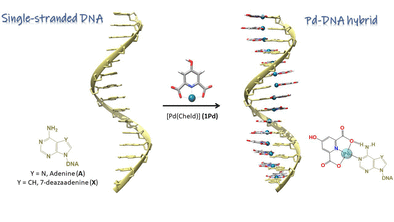Mar 29 2021
Nanowires are, undoubtedly, crucial components for next-generation sensors, nanoelectronics, and nanomedicine.

Image Credit: © Wiley-VCH, Angewandte Chemie International Edition.
To obtain the needed complexity, the growth and position of the metal chains should be controlled on an atomic level.
Now, a team of researchers has developed a new technique that produces helical, accurately-controlled, palladium-DNA systems that imitate the arrangement of natural base pairs existing in a double-stranded DNA molecule.
The study has been reported in the Angewandte Chemie International Edition journal.
Headed by Miguel A. Galindo, the researchers from the United States and Europe have particularly designed this elegant technique to produce continuous, individual chains of palladium ions. The new process is built on the self-organized assembly of single-stranded DNA molecules and a unique palladium complex.
In the recent past, DNA has turned out to be a significant tool in the field of nanotechnology and nanoscience, specifically because the resulting structures could be “programmed” via the base sequence of the DNA utilized. Metals incorporated into the DNA structures can give them several properties, like photoactivity, conductivity, magnetism, and catalytic activity.
But it is not a trivial task to arrange metal ions in the DNA molecules because these metal ions can attach to several different locations. Hence, Galindo’s research team has designed an intelligent technique for regulating the attachment of palladium ions to particular locations.
A uniquely built palladium complex was used by the researchers that can create base pairs with the natural adenine bases in a DNA strand. Within this complex, the ligand exists as an aromatic, flat ring system that seizes three of the four binding positions that are available on the palladium ion. Following this, the fourth position of the palladium ion becomes available to attach to a highly specific nitrogen atom in adenine.
Besides this, the ligand contains oxygen atoms that can form a hydrogen bond with the adjacent NH2 group of the adenine. A binding pattern like this precisely matches with a Watson-Crick base pairing but is presently controlled by a palladium ion, which renders it significantly stronger when compared to this natural Watson-Crick base pairing.
If a single DNA strand made entirely of adenine bases is utilized, one palladium complex will attach to every adenine. The flat ligands self-assemble into coplanar stacks, similar to natural bases.
This leads to a double strand composed of palladium complexes and DNA that is similar to a natural DNA double helix wherein a single strand has been substituted by a supramolecular stack of constant palladium complexes.
While the researchers are yet to show the conductive characteristics of these systems, it can be assumed that the precise reduction of such metal ions may result in the development of a conductive nanowire that has an extremely controlled structure.
At present, the team is working along this line and is also looking for ways to alter the ligand, which can also impart novel properties to the system.
Journal Reference:
Pérez‐Romero, A., et al. (2021) Single‐Stranded DNA as Supramolecular Template for One‐Dimensional Palladium(II) Arrays. Angewandte Chemie International Edition. doi.org/10.1002/anie.202015554.